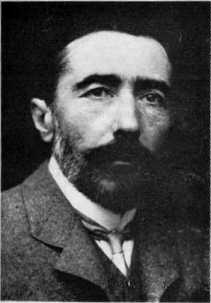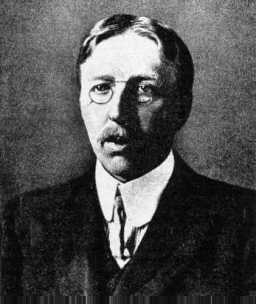
Joseph Conrad in 1904 |

Ford Madox Ford circa 1906 |
Relationships are extraordinarily indefinable things.
Ford Madox Ford, Joseph Conrad: A Personal Remembrance
Joseph Conrad and Ford Madox Ford (or Ford Madox Hueffer, as he was then known) began their collaboration with one another late in 1898, when Ford was 24 and Conrad 41. Conrad had by that time produced several works: Almayer's Folly (1895), An Outcast of the Islands (1896), The Nigger of the 'Narcissus' (1897), and Tales of Unrest (1898), and was at the time contemplating what would become Lord Jim (1900). Similarly, Ford was a fairly well-known author, having already published the popular children's stories The Brown Owl (1891) and The Feather (1892), a novel called The Shifting of the Fire (1892), a collections of poems (1893), and a biography of his grandfather, Ford Madox Brown (1896).

Joseph Conrad in 1904 |

Ford Madox Ford circa 1906 |
Neither had reached the apex of his respective career: Conrad's Under Western Eyes (1911), Chance (1913) and Victory (1915) were a decade or more away, as were Ford's The Good Soldier (1915) and the Parade's End tetralogy.
It is rare to find two twentieth-century masters writing with (and for) one another, and particularly rare to find two doing so at the time when each was relatively unknown and in the process of formulating his theories and models of novel-writing.
Given that this particular collaboration materially produced what should now be rightly seen as perhaps the single most important structural element of modernist literature -- the unreliable narrator -- one would imagine, therefore, that Ford and Conrad's collective works -- two novels and a novella -- would have already been carefully raked over by several generations of literary scholars searching for evidence of the theories, models and epistemological modes that distinguish Conrad and Ford from the other novelists of the first half of the twentieth century, and mark each as among the century's greatest practitioners of novel-writing.
Instead, what we find, when we look either at the academic work on Conrad, or on Ford, is disdain, ignorance, rumour-mongering and dismissal. Almost without exception, Conrad scholars find Ford an oaf and a liar, capering on the margins of their hero's career, telling tales out of school about the Master's views of this or that, and taking credit for far too much of the writing of far too many Conrad novels to be credible. Similarly, Ford scholars find Conrad a cold-hearted, mean-spirited manipulator, taking Ford's hospitality, his money, his connections and in many cases his hands, heart and mind, while simultaneously belittling Ford and Ford's work to others. Neither camp finds the collective works up to the standards of their respective hero, and all conclude, explicitly or implicitly, that nothing very interesting in the way of literature came out of the nearly seven years that Ford and Conrad spent working together.
Ford was indeed a liar, though a largely benign one, and Conrad was a heartless, fickle user of people (though he seems not to have noticed, for the most part, just how heartless he was). Both men were neurotic in the extreme, about their work and about their lives. Both recast - Ford several times in fact - the substance and the import of their collaboration, as the career of each waxed and (in Ford's case at least) waned. The three works the two co-authored -- The Inheritors (1901), Romance (1903) and The Nature of A Crime (1909) -- are indeed nowhere near as good as either novelist's mature solo work.
But all of these "facts" distract us from yet another, far more salient, fact. When Ford and Conrad began their collaboration -- at the instigation of Edward Garnett, who hoped Conrad would be able to help Ford make something of his theretofore-unpublishable novel Seraphina -- neither Ford nor Conrad had any satisfactory theory of the novel. Although Ian Watt [Watt, p. 257] and other Conrad scholars have denied that Conrad ever arrived at any systematic theory of the novel, even a cursory reading of Conrad's prefaces to various of his works is enough to convince us that he had at minimum a working theory, and that at the heart of that theory was a concern for the epistemological position of the author and his narrator with respect to the matter of the narrative and to the larger world that the narrative implied. Ford, too, was concerned abut the complex epistemological problems of novel-writing, and in particular with the separation, on the one hand, between author and narrator, and, on the other hand, the narrator's immersion in the story for which he (or she) is responsible.
Conrad and Ford collaborated on texts, true enough, but those texts are less works of fiction than experiments in novel-writing: texts in service of theory. Seen properly, the collaborative works of Conrad and Ford -- along with the fourth "fiction" of the collaboration, Ford's Joseph Conrad: A Personal Remembrance (1924) -- are the only documentary evidence of a series of discussions and experiments that two of the greatest novelists of the twentieth century undertook in one another's company, at one another's instigation, and in some cases together: to produce a twentieth-century novel, an art form equal to the complexities and ambivalences of modern life.
For that reason, the collaborative texts have a documentary, evidentiary, archeological claim on all serious scholars of modernist literature, and particularly on those scholars who, like me, believe that Ford and Conrad, at their best, are the best of the twentieth century.
And, for that reason, this site provides reliable electronic versions of each of the collaborative texts -- The Inheritors, Romance and The Nature of A Crime -- as well as Joseph Conrad: A Personal Remembrance, along with a discussion of the historical background to the collaboration.
All commentary, criticism and collaboration are welcomed.